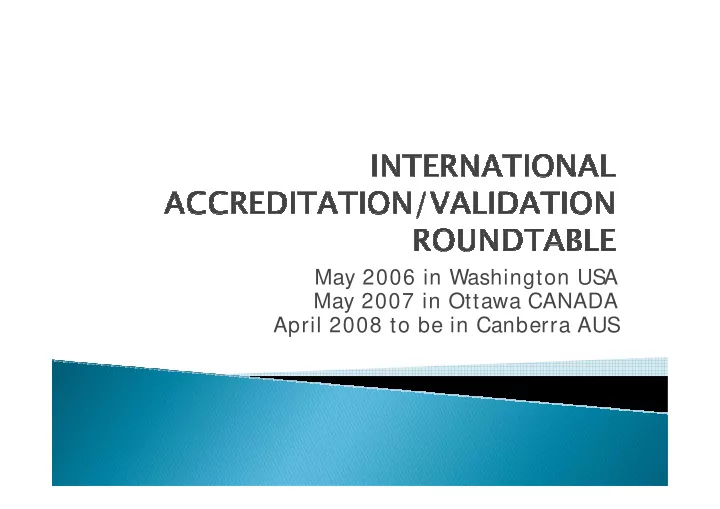

May 2006 in Washington USA May 2007 in Ottawa CANADA April 2008 to be in Canberra AUS
� Session 1 – Session 1 – Student Performance tudent Performance Methodology utilized by the ARB to evaluate student performance Presenter: Dr. J on Levett, Head of Education, ARB Discussion of the various methods utilized to develop and assess student performance, and the importance of student performance to the accreditation/ validation process
� Session 2 – Session 2 – Funding and Governance unding and Governance Presentation of the funding and governance policies of the National Architectural Accrediting Board, USA Presenter: Sharon Matthews, AIA, Executive Director, NAAB Discussion of funding mechanisms currently in- place by the Conference participants, and the degree to which funding impacts the governance of the accreditation/ validation process
� Session 3 – Session 3 – The Quality of Arch he Quality of Architectural Education within the itectural Education within the Global Context Global Context Policies/ procedures employed by the CAA to ensure the quality architectural education within the Commonwealth countries Presenter: George Henderson, CAA Validation Panel Chair Discussion of how each Conference participant organization assumes the responsibility for the quality of architectural education within the global context and the importance of including that responsibility within the organization’s mission
GUIDELI GUIDELINES OF GOOD PRACTI ES OF GOOD PRACTICE CE INTRODUCTION INTRODUCTION While it is believed that the Guidelines will be of interest to all those who are � concerned with quality assurance in higher education, they are specifically addressed to quality and assurance agencies who will be referred to in this statement as External Quality Assurance Agencies (EQAAs). � The overarching purpose of the Guidelines is to promote good practice in � external quality assurance and its aims can be expressed more specifically as follows: � To promote professional development among EQAAs and their staff. � To be used as part of the criteria in the self and external evaluation of � EQAAs. To use as a framework to guide the construction of a new EQAA. � To promote the public accountability of EQAAs. �
TH THE BA E BASIC CONDITIONS FOR THE SIC CONDITIONS FOR THE GUID GUIDELINES OF GOOD PRACTICE ELINES OF GOOD PRACTICE When reading and working with the Guidelines of Good Practice the following � should be taken into consideration: � The Guidelines are intended to promote good practice and assist an Agency � in improving its quality building on existing experiences. That each EQAA has evolved to serve a specific context and that this is � influenced by its cultural and historical context. That there exist a diversity of approaches to, and purposes for, external � quality evaluation (e.g. but not restricted to accreditation, assessment and audit), but that these approaches can be underpinned by some common agreed principles. (The words ‘evaluation’ or ‘EQAA’ will be used as generic terms to include all types of external quality checking.) The Guidelines should not lead to The Guidelines should not lead to the dominance of one specific view or the dominance of one specific view or � approa approach, but promote good practice, ch, but promote good practice, while helping to eradic ile helping to eradicate ate the the bad. bad.
Draft Draft � Canberra Accord on Architectural Education � RECO RECOGNI GNITION OF SUBSTAN ION OF SUBSTANTIAL EQ IAL EQUI UIVALEN VALENCE B E BETWEEN A TWEEN ACCREDI CREDITATIO ATION/ VALIDATION VALIDATION � SYSTEMS IN ARCHITECTURA SYSTEMS IN ARCHITECTURAL ED L EDUCA UCATION ION First Draft: J une 15 2007 � Introduc Introduction tion � Architectural accreditation/ validation signifies that a program/ me or academic � qualification in architecture has been evaluated by an accreditation/ validation body and deemed to meet established academic standards. Notwithstanding the differences between their accreditation/ validation systems, the signatories to this Accord agree that there is substantial comparability. This being the case, academic qualifications in architecture accredited/ validated by one of the signatories should be accepted as being substantially equivalent and recommended for recognition by all signatories, subject to additional requirements imposed by local regulations. AGREEMENT: AGREEMENT: � Having exchanged information on and examined their respective criteria and procedures � for accrediting/ validating academic qualifications in architecture (including systems recognition agreements), the signatories have concluded that their systems are substantially equivalent. Through the Canberra Accord, which comprises this Agreement and the Rules and Procedures, the signatories recognize the comparability of their systems in terms of accrediting/ validating the academic requirements for the practice of architecture at the professional level.
� Process for bringing new signatories to the Accord � Definition of boundaries or limits for activities of signatories to accommodate developing systems � Process for making changes that respond to the needs of the profession while maintaining substantial equivalency of systems
Sharon Carter Matthews, AIA Executive Director National Architectural Accrediting Board
Recommend
More recommend